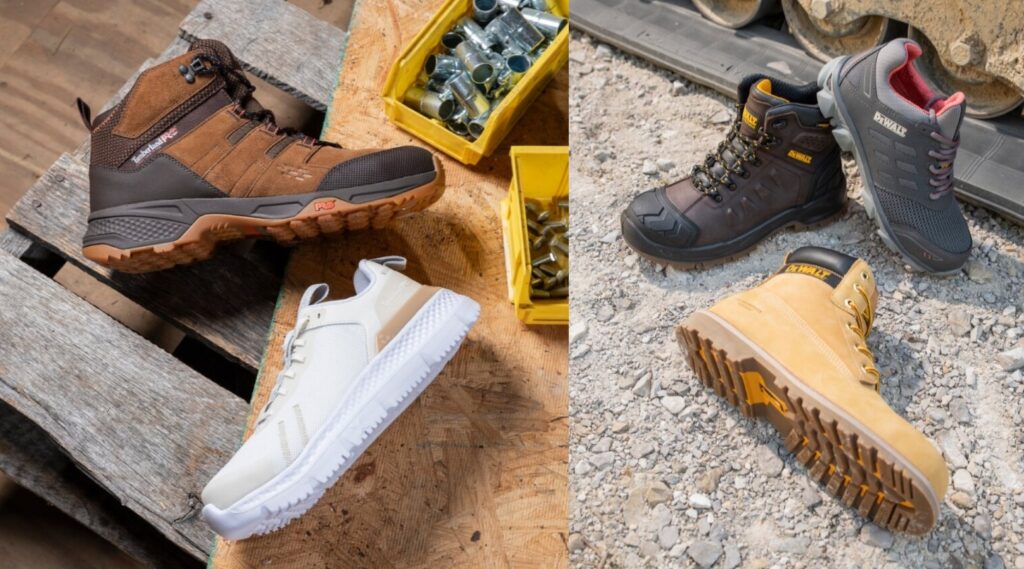
Steel Toe Boots vs. Alloy Toe Boots vs. Composite Toe Shoes
With the new year comes new gains, and recent market forecasting suggests that over the next few years and beyond, interest in and demand for footwear categorized as ‘Safety Toe Work Boots’ are expected to expand considerably. Steel toe boots (or alloy toe), safety shoes, and composite toe footwear are considered the primary segments in this arena, and the projected demand growth seems to be driven by the thriving industrial demand where safety toe shoes are required, e.g. construction, manufacturing, mining, oil and gas.
The report which presents the exciting research and analysis within the Safety Toe Work Boots Market Research expresses high expectations for this sector of workplace footwear, expectations that are echoed in the Industrial Safety Footwear Market, which is projected to see a Compound Annual Growth Rate of at least 2.5% within the next decade. Okay, enough with the boring market research chatter that interests only us nerds; let’s get to the good stuff- footwear for the workplace!
Safety Toe Work Boot Standards
When it comes to shopping the best work boots or safety shoes, there are a few key factors to consider, toe and foot protection being of the utmost importance. Before we get into the specifics, let’s understand how footwear safety standards in regards to impact protection and compression resistance are determined. In the United States, safety footwear regulations in the workplace are established and enforced by national safety and health authorities.
- The Occupational Safety and Health Administration (OSHA) sets and enforces workplace safety standards, including those related to protective footwear. It’s their mission “to ensure safe and healthful working conditions for workers by setting and enforcing standards and by providing training, outreach, education and assistance.”
- ASTM International develops and publishes technical standards for a wide range of products, materials, systems, and services, including safety footwear. In particular, ASTM F2413-18 Standard Specification for Performance Requirements for Protective (Safety) Toe Cap Footwear, which covers minimum requirements for the performance of footwear to provide protection against various workplace hazards that could lead to injury.
Steel Toe, Alloy Toe, or Composite Toe?
Let’s explore specifics and key differences such as hazard protection, price, comfort, durability, customer rating, and style to compare the pros and cons. This will help you make an informed decision next time you’re shopping for safety toe shoes or boots for the workplace.
Pros & Cons of Steel Toe Boots
As the most common type of safety toe footwear, work boots with steel toe caps provide the necessary impact protection and compression resistance required by OSHA and they are built to meet the demands of construction jobs, industrial settings, and other potentially hazardous work environments.
Pros: Very durable, high-quality construction using leather, suede, nylon, synthetic, and/or waterproof materials. Steel toe boots are the most affordable type of safety toe work shoe, and with the extensive array of brands and styles available, they are also the most versatile.
Cons: Steel toe work boots are cumbersome, heavy, and can become uncomfortable during long shifts or fast-paced work. The conductivity of steel toe caps makes them susceptible to electrical hazards and hot/cold temperature extremes, rendering them vulnerable in extreme conditions.
The dependability of steel toe work boots is indisputable, and their comparable low-cost makes them the cheapest option, without sacrificing quality and critical safety standards. If dependable toe protection is needed but budget is a concern, steel toe work boots are the way to go as long as they will be worn in a workplace with minimal electrical hazard risk.
Pros & Cons of Alloy Toe Boots
In regards to OSHA compliance, durability, and design features, alloy toe work boots are generally parallel to those of their steel toe counterparts. However they carry the advantage of lighter construction and thinner toe caps, so comfort and agility are where alloy toe boots reign supreme. This option is ideal for those that need foot protection but also require comfort during long shifts spent standing or walking. Painters, carpenters, mechanics, custodians, and construction workers can all benefit from a quality pair of alloy toe work boots.
Pros: Alloy toe caps are lighter and thinner than steel, so in addition to meeting safety standards, alloy toe boots are less bulky and make for a lighter step.
Cons: More expensive than steel toe boots. Although alloy toe boots do not conduct electricity, they do transmit cold and heat, so extremely cold, or extremely hot conditions can impact comfort. Style variations of alloy toe boots are a bit more limited in comparison to steel toe, but still available from preferred work wear brands.
Alloy toes stack up well against steel toes, but workers in need of a lighter, more comfortable safety toe shoe or work boot should opt for alloy. Although higher in price, the upgrade is worth the investment.
Pros & Cons of Composite Toe Footwear
Composite toe safety shoes and work boots are constructed with durable OSHA approved, non-metallic materials, and feature toe caps made of carbon fiber, plastic, Kevlar, or fiberglass. They offer comparable levels of protection in comparison to steel or alloy, but composite toe shoes are lighter, more comfortable, non-conductive, and non-magnetic so they provide safety, support, and agility across a wider range of work environments.
Pros: Keeps workers better protected against electrical hazards. Non-metallic design features offer the added benefit of bypassing metal detectors and security checks for a hassle free workday. OSHA approved toe protection.
Cons: More expensive than steel toe and alloy toe footwear. Durable build, but any forceful impact with the toe cap decreases durability and shortens lifespan, which can even be compromised after a single workplace accident.
The lightweight, non-conductive, non-metallic properties of composite toe safety footwear make them an excellent choice for certified foot and toe protection, even though they come at a higher cost in comparison to steel toe boots and alloy toe boots.

14 Comments
Comments are closed.